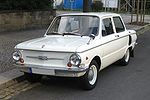Saporoshez (make of car)
The Zaporozhez ( Ukrainian Запорожець , Russian Запорожец - Zaporozhez , "the one from Zaporozhye ") was an automobile series of the Soviet or Ukrainian manufacturer Saporisky Awtomobilebudiwny Sawod (SAS) in the city of Zaporischschja; the series was produced from 1960 to 1994. Colloquially, the vehicles in Germany - especially in the GDR - were mostly called Saporosch or simply Sapo . In the Western European countries, Saporoshez was sold under the export names Yalta / Jalta , Eliette and ZAZ .
Models
SAS-965
The SAS-965 / 965A model was built between 1960 and 1969. It had a self-supporting body, the design of which was based on the Moskvich-411 and Moskvich-444 (prototypes from 1958). The front part of the vehicle was strongly reminiscent of a Fiat 600. The car was powered by an air-cooled V4 engine with a displacement of 746 cc mounted in the rear. This engine, partly made of aluminum, developed 23 hp. The basic model left the assembly line between 1960 and 1963, the version SAS-965A with a larger and more powerful engine between 1962 and 1969 - the latter can be recognized by the changed air inlets and a newly designed logo as well as a starter instead of a crank opening. Due to its unusual shape, the SAS-965 / 965A was nicknamed "the hunchback" in the Soviet Union . Both types had so-called suicide doors .
SAS-966
The SAS-966 model was built between 1966 and 1972, its almost 3.80 m long body now resembled the NSU Prinz 4 , technology and engine were initially only slightly further developed (transitional model SAS-966W, Cyrillic: ЗАЗ-966В ). In 1967 SAS-966 got a new 1197 cm³ V4 engine with 40 HP (MeMZ-968).
SAS-968
In 1971, SAS-966 was replaced by the technically revised model SAS-968. The body remained unchanged except for small details such as additional lights. After further changes, a newer model SAS-968A without chrome grill came in 1973, which was produced until 1979. These vehicles were equipped with 40 and 45 hp engines.
SAS-968M
From 1979 until production was discontinued in 1994, the slightly modified model SAS-968M was built. The use of plastic parts reduced the vehicle weight by 40 kg. The SAS-968M was replaced by the SAS-1102 Tavria , a station wagon with front-wheel drive and water-cooled front engine, which had been manufactured since 1987 .
A total of 3,422,444 cars rolled off the assembly line in the years 1960–1994.
export
The Saporoshez was offered since the sixties in Belgium under the name Yalta , in the Netherlands , Denmark and Finland - Yalta , in Austria - Eliette and in some Western European countries (including Belgium, Netherlands, Italy ) later as ZAZ . For most export markets, however, the original name was retained and its spelling was adapted to the respective national language. Like the Moskvich , the SAS-966 was temporarily assembled in Belgium as the Yalta 1000 , and some of the cars manufactured there were equipped with the engine of the Renault 8 .
Export to the GDR
Export to the GDR began in 1967. The models SAS-965A, SAS-966, SAS-968 and SAS-968A were delivered. The selling price was 7530, - Marks for the SAS-965A and 11,950, - for the SAS-966/968. The Saporoshez was superior to the Trabant in some respects: its 40 hp made it possible to drive quickly even on steep inclines, there was plenty of legroom at the front due to the rear engine and the seats are well sprung. A particular advantage of the Saporoshez compared to the Trabant was that it was temporarily available without waiting. However, the small trunk in the bow deterred potential buyers. The quality of workmanship corresponded to the “Soviet standard of that time” and continued to decline over the years; therefore, in 1979, the import into the GDR was stopped. The air-cooled rear engine tended to overheat at speeds over 90 km / h. The petrol-powered heater could lead to a vehicle fire if it was not repaired by an expert. The even axle load (60% on the driven rear axle), the smooth underbody and the low total weight made the Saporoshez very off-road.
In the 1970s, the Saporoshez accounted for three to four percent of the GDR's car population. Even in the GDR era, the Saporoshez left the streets quite quickly. The Saporoshez has become rare even in the native Ukraine. The 968M, which was also air-cooled and improved in details, was not exported to the GDR.
Nicknames
The reputation of Saporoshez can be seen in the nicknames of the time: "Stalin's last revenge" (see literature), "Fidget frog", "Kremlin bug", "Russian tank". Other names were "drool frog", "Soljankaschüssel", "Khrushchev's Vengeance", " T-34 Sport", "Kolkhozentraktor" or "Taiga drum". Some of these names were also used for other vehicles from the USSR. The LTS M62 locomotive was also known as the Taiga drum. Also known in the GDR was the saying: "Whoever thrashed an ox (a donkey, a goat ...) in the past drives a Zaporozhye". This meant LPG farmers who, compared to city dwellers, were much more likely to buy a Saporoshez that was suitable for off-road use. In the Russian-speaking world, the car was briefly called “Запор” ( Sapor ), which is tellingly synonymous with “locking”, but also “clogging”.
Technical specifications
| SAS-965 | SAS-965A | SAS-966W | SAS-966 | SAS-968 | SAS-968A | SAS-968M | ||
|---|---|---|---|---|---|---|---|---|
| Construction period | 1960-1963 | 1962-1965 | 1966-1969 | 1966-1967 | 1967-1972 | 1971-1973 | 1973-1979 | 1979-1994 |
| Engine type | MeMZ-965 | MeMZ-966 | MeMZ-966A | MeMZ-968 | MeMZ-968 MeMZ-968A |
МeМZ-968E, MeMZ-968GE, MeMZ-968BE | ||
| Engine type and number of cylinders |
Air-cooled four-cycle carburettor V4 - Otto engine , arrangement along the rear | |||||||
| Valves | 8 ( hanging ) | |||||||
| Displacement | 746 cc | 887 cc | 1,196-1,197 cc | 1,197 cc | ||||
| Max. Power at 1 / min |
23 hp 4000 |
27 hp 4000 |
30 hp 4000-4200 |
27-30 PS 4200-4400 |
40 hp 4200-4400 |
40 hp (4200–4400) 45 hp (4400–4600) |
41 hp, 45 hp, 50 hp 4400-4500 |
|
| Drive, as standard | Rear | |||||||
| Gearbox, as standard | 4-speed manual transmission | |||||||
| Top speed, km / h | 80 | 90 | 100 | 100 | 118 | 118 123 |
120 | |
| Acceleration, 0–100 km / h in s |
17 (0-60 km / h) | 13.5 (0-60 km / h) | 34 | 32 | 32 | |||
| Fuel consumption in l / 100 km |
6.5 | 5.5 | 5.5 | 5.9 | 7.9 (at 100 km / h) | 7.4 | 6.5 (at 100 km / h) 9.5 (in city traffic) |
|
|
Emission standard according to EU classification |
no | |||||||
Trivia
In the cartoon Cars 2 , "Vladimir Trunkov" is a Saporoshez SAS-968; Original speaker: Stanley Townsend, German dubbing: Hartmut Neugebauer .
Vladimir Putin's first car was a Zaporozhez - his mother won it in the lottery. He is still considered a fan of this brand to this day.
literature
- Volksfiatowitsch . In: Der Spiegel . No. 30 , 1960 ( online - July 20, 1960 , about the first model and its role models VW and FIAT 600).
- Hein Werner: I drive a Saporoshez. Type 965A, 966, 968, 968A . 4th revised edition. transpress VEB publishing house for transport, Berlin 1979, DNB 800134826 .
- Michael Birken: Stalin's Last Revenge. Adventurous novel . Fuchsbau Verlag, 2001, ISBN 3-8311-1266-5 (A journey with the Saporoshez through the GDR).
- Nasur Yurushbaev, Jefim Replijansky: Saporoshez. Built from 1960–1994. From bread roll holder to T 34 Sport. Vehicles of the East . UAP Video, Leipzig 2013 (DVD, 45 min).
- Bernard Vermeylen: Cars from the Eastern Bloc: All models since 1945 . Delius Klasing, Bielefeld 2010, ISBN 978-3-7688-3149-9 .
Individual evidence
- ↑ History of Russian automobiles (Russian)
-
↑ a b c d e f g h i j k l m The car that nobody wanted - The Saporoshez. In: mdr.de. October 15, 2013, accessed March 8, 2015 . Post on Youtube
- 1:38 "In 1967 the first Saporoshez came to the GDR [...] While you had to wait for years for a Trabant at that time, the Saporoshez was available immediately. "
- 1:58 "Word gets around quickly that the car is neither suitable for fast nor for long journeys. "
- 2:57 " The two-stroke engine from Zwickau is in some ways superior to the Saporoshez. It is available with 40 hp [...] Where the Trabant struggles up the mountain, the Saporoshez passes easily. The driver and front passenger have plenty of legroom [...] ] and the seats are well sprung. "
- 3:43 " The tiny trunk scares off car buyers. "
- 4:01 “ The gasoline-powered heater also spreads horror. ”
4:37 “ It happened regularly that cars simply burned down because many tried to repair the heater themselves, and when the seal was damaged, it was dripping right down on the heater. " - 5:01 " The engine runs hot at over 90 km / h. "
- 5:36 " [...] The spare parts situation and workmanship are getting worse and worse. The quality corresponded to the Soviet standard of the time. Of course there were some inconsistencies in German terms or there were a few leaks in the body or rattling noises. "
5:58 "In 1979 the import into the GDR is stopped - the quality defects are too great. " - 7:08 " By the way, a prominent Sapo fan is none other than Russian President Vladimir Putin. It was his first car that his mother won in the lottery. "
-
↑ History of Russian automobiles (Russian)
"Гладкое днище и хорошая загрузка ведущих колес (60% от полной массы) обеспехили обеспехмю.
"[A] smooth underside and a good load on the drive wheels (60% of the total mass) provided them with [a] good off-road mobility." - ^ Benno Weiß: Plauen, Morgenbergstrasse. A German-German chronicle . Books on Demand, Norderstedt 2005, ISBN 3-8334-2980-1 , pp. 25 .
- ↑ Google Books: Silberling und Irons: 1000 nicknames in transport and traffic and what's behind them , Richard Deiss, BoD - Books on Demand, 2010.
- ↑ a b c freiepresse.de: My oldie - screwdriver-friendly and better than its reputation
- ^ Martin Sabrow: Places of Remembrance of the GDR - Google Books. In: books.google.de. P. 368 , accessed on February 27, 2015 .
- ↑ Saporoshez - Interview with Klaus-Ulrich Schultz in the Leipziger Volkszeitung March 31, 2005. In: saporoshez-968.de. Retrieved February 27, 2015 .
- ^ Saporoshez in the GDR. In: www.youtube.com. Retrieved May 12, 2019 .
- ↑ See: Foreign Cars in Russia , accessed on February 1, 2014.
Web links
- Saporoshez Interest Group Germany - The website of the Saporoshez friends (including the Saporoshez forum)








